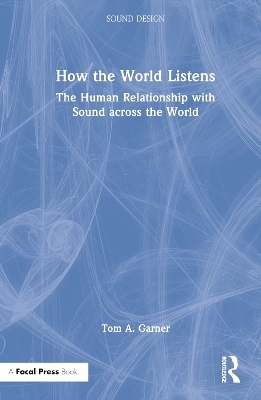
How the World Listens
Focal Press (Verlag)
978-1-032-01453-1 (ISBN)
This book asks how sound is perceived, expressed and interacted with in both remarkably similar and dramatically different ways across the world. Using findings from a new scientific study, conducted exclusively for this book, we embark on a globe-trotting adventure across more than thirty countries, through exclusive interviews with more than fifty individuals from all walks of life, from acousticians and film composers to human resource managers and costumiers.
How the World Listens is essential reading for anyone with an interest in human relationships with sound, including but not limited to sound design and music composition professionals, teachers and researchers.
Tom A. Garner is a Senior Lecturer in Interactive Technologies at the University of Portsmouth. Originally from a background in popular music performance, Tom now works extensively in emergent approaches to auditory perception and extended reality (XR) technology. His previous books include Sonic Virtuality and Echoes of Other Worlds.
CONTENTS
List of Figures
List of Tables
Acknowledgements
INTRODUCTION
Origins and precedent
The habitus
Sociocultural theory
CHAPTER ONE: SOUND AND THEORY
Asking the right questions
A (quite) brief review of sound theory & perspectives
What is sound?
Sound as a soundwave
Sound as an object or an event (or both […] or neither)
Extending sound theory even further
Beyond the acoustic definition
What is listening and how is sound controlled?
Typologies of listening
The function of sound
Acoustic ecology
Chapter One summary: questions begetting questions
CHAPTER TWO: SOUND AND RESEARCH
The madness, the methodology, and the method
The chain of study design, and its four links
The research onion
Approaching ethnography
Qualitative v. quantitative
The function and values of ethnography (and when to use it)
Some key trends in ethnography
Autoethnography
Is ethnography the right choice for studying sound?
Making sense of sound studies
Ethnomusicology, for a bit of history
Does sound studies actually study sound?
Approaching sound studies
So, you want to do some interviews?
When and how to use an interview
The ethnographic interview
Analysing interview results
How can technology help?
The chosen method
Chapter Two summary: So, how did it all go then?
CHAPTER THREE: SOUND AND MEANING
Immediate reactions
Emergent themes
Objective aspects of sound
Meaning through definition
Perceptual responses
Immersion and persistence in sound
The listener
Functions and values
The affordances of sound
The value of sound
Affect and identity
Feeling and the emotional aspects of sound
Music, affect, and identity
Sound and spirituality
Meaning through work
Chapter Three summary: the meaning of sound’s meaning
CHAPTER FOUR: SOUND AND CULTURE
Themes of culture and sound in research
Earlier research
More contemporary perspectives
How should we be defining ‘culture’?
Initial thoughts from the interviews
Short and sweet responses
Detailed, and a little more intimate
Emerging topics for further discussion
The sound of coffee
Synaesthesia
Music and culture
Local, historical, and seasonal effects
Voice and language
Religion and ceremony
Chapter Four summary: not something I normally think about
CHAPTER FIVE: SOUND AND PLACE
How does the world sound?
Conceptualising the soundscape
Continental soundscapes
The Big Ice
Application of soundscape studies
Pre-interview observations of sound and place
Some local perspectives
A question of sport
The quiet revolution of electric vehicles
Application of soundscape studies
Europe and the Russian federation
Sonic boundaries and the sounds of city and countryside
Meteorological effects
Asia and Oceania
Defining the Eastern soundscape
Different beeps and louder dogs
Soundscapes and routine
Common features, topology, and long-term human influences
The Americas
Biodiversity and the effects of migration
The calls of commerce
Africa
Tradition and spirituality
Transportation
A brief epilogue: sound everywhere and nowhere
Chapter Five summary: there’s a lot going on
CHAPTER SIX: SOUND AND EVERYDAY EXPERIENCE
How does sound function in your everyday life?
Background sound
Situational awareness
Challenges with sound
What is your relationship with sound within your home?
Outside sound sources and architectural effects
Sources of sound from inside the home
Sound, stress, anxiety, and relaxation in the home
Good and bad sound in an everyday context
Pre-interview observations
The good, the bad, and the "well, it depends…"
The etiquette of sound
Sound-etiquette in domestic life
Respectful sound in public
Social sound and vocal expression
Chapter Six summary: who doesn’t like the sound of a crow cawing?
CHAPTER SEVEN: SOUND AND PROFESSIONAL PRACTICE
How does sound feature in your profession?
General functions of sound at work
Sonic warfare
Sound professional by industry
Digital games
Film and theatre
Sound professionals’ relationships with sound
Awareness and readiness to capture
Impact on everyday enjoyment
Changes in perspective
Perceptual effects
Cultural factors, expectations, and creative response
Cultural effects on practice
Universality and concerns over detracting from the art
Different standards and expectations
The return of the East-West dichotomy
A few further examples
Chapter Seven summary: on the verge of global sound?
CONCLUSION
Final answers
Is the human relationship with sound different around the world?
What did you learn from your autoethnography?
Do you still hate qualitative research?
Index
| Erscheinungsdatum | 07.09.2022 |
|---|---|
| Reihe/Serie | Sound Design |
| Zusatzinfo | 3 Tables, black and white; 6 Line drawings, black and white; 1 Halftones, black and white; 7 Illustrations, black and white |
| Verlagsort | Oxford |
| Sprache | englisch |
| Maße | 156 x 234 mm |
| Gewicht | 453 g |
| Themenwelt | Kunst / Musik / Theater |
| ISBN-10 | 1-032-01453-9 / 1032014539 |
| ISBN-13 | 978-1-032-01453-1 / 9781032014531 |
| Zustand | Neuware |
| Haben Sie eine Frage zum Produkt? |
aus dem Bereich


